

Aeternitas. The divinity sometimes appears as Aeternitas Imperii (the "Eternity of Roman rule"),[5] where the Latin word imperium ("command, power") points toward the meaning "empire," the English word derived from it.
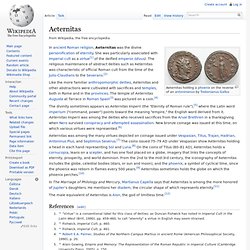
Aeternitas Imperii was among the deities who received sacrifices from the Arval Brethren in a thanksgiving when Nero survived conspiracy and attempted assassination. New bronze coinage was issued at this time, on which various virtues were represented.[6] Jump up ^ "Virtue" is a conventional label for this class of deities; as Duncan Fishwick has noted in Imperial Cult in the Latin West (Brill, 1990), pp. 459–460, to call "eternity" a virtue in English may seem strained.Jump up ^ Fishwick, Imperial Cult, p. 460.Jump up ^ Fishwick, Imperial Cult, p. 461.Jump up ^ Robert E.A.
Ananke (mythology) The goddess,"Ananke" is derived from the common Ancient Greek noun ἀνάγκη, (Ionic αναγκαίη : anankaiê) meaning force, constraint or necessity.

Homer uses the word meaning necessity ( αναγκαίη πολεμίζειν, "ιt is necessary to fight") or force (ἐξ ἀνάγκης, "by force" ).[3] In Ancient Greek literature the word is also used meaning fate or destiny, ( ανάγκη δαιμόνων, "fate by the daemons or by the gods"), and by extension compulsion or torture by a superior.[4] The word is often personified in poetry, as Simonides does: "Even the gods don’t fight against ananke".[5] In the philosophical sense it means necessity, logical necessity,[6] or laws of nature[7] The word "Ananke" is featured in Victor Hugo's novel Notre-Dame of Paris, written upon a wall of Notre-Dame by the hand of Dom Claude Frollo.
In his Toute la Lyre, Hugo also mentions Ananke as a symbol of love. Anna Perenna. Anna Perenna was an old Roman deity of the circle or "ring" of the year, as the name (per annum) clearly indicates.
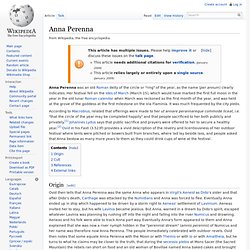
Her festival fell on the Ides of March (March 15), which would have marked the first full moon in the year in the old lunar Roman calendar when March was reckoned as the first month of the year, and was held at the grove of the goddess at the first milestone on the Via Flaminia. It was much frequented by the city plebs. According to Macrobius, related that offerings were made to her ut annare perannareque commode liceat, i.e. Origin[edit] Ovid also tells that Anna, although Magistra Silverman believes her to be fully grown, was actually a person of small stature. Franz Altheim [3] thinks that Anna Perenna is one of the etruscan gods imported into the romain religion. Antevorta. In ancient Roman religion, Antevorta was a goddess of the future, also known as Porrima.
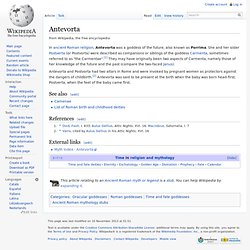
She and her sister Postverta (or Postvorta) were described as companions or siblings of the goddess Carmenta, sometimes referred to as "the Carmentae".[1] They may have originally been two aspects of Carmenta, namely those of her knowledge of the future and the past (compare the two-faced Janus). Antevorta and Postvorta had two altars in Rome and were invoked by pregnant women as protectors against the dangers of childbirth.[2] Antevorta was said to be present at the birth when the baby was born head-first; Postverta, when the feet of the baby came first. See also[edit] References[edit] External links[edit] Myth Index - Antevorta.
Caerus. For the philosophical term for opportunity, see Kairos.

In Greek mythology, Caerus or Kaerus (Greek: Καιρός, Kairos) was the personification of opportunity, luck and favorable moments. He was shown with only one lock of hair. His Roman equivalent was Occasio or Tempus. Caerus is the youngest child of Zeus. Caerus and Fortuna became lovers after Caerus neglected to overthrow his father as everyone thought he would. Caerus is the due measure that achieves the aim. Caerus is represented as a young and beautiful god. A. Camenae. In Roman mythology, the Camenae (/kəˈmiːniː/; also Casmenae, Camoenae) were originally goddesses of childbirth, wells and fountains, and also prophetic deities.
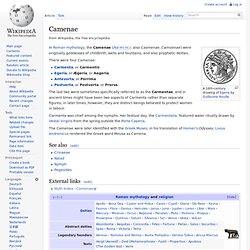
There were four Camenae: The last two were sometimes specifically referred to as the Carmentae, and in ancient times might have been two aspects of Carmenta rather than separate figures; in later times, however, they are distinct beings believed to protect women in labour. Carmenta was chief among the nymphs. Carmenta. In ancient Roman religion and myth, Carmenta was a goddess of childbirth and prophecy, associated with technological innovation as well as the protection of mothers and children, and a patron of midwives.

She was also said to have invented the Latin alphabet. Background[edit] Porta Carmentalis (at location 12) Chronos. Chronos, sleeping on the grave of Georg Wolff, a merchant Chronos (Ancient Greek: Χρόνος, "time," also transliterated as Khronos or Latinized as Chronus) is the personification of Time in pre-Socratic philosophy and later literature.
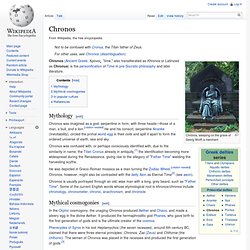
Mythology[edit] Mythical cosmogonies[edit] Egeria (mythology) A 16th-century drawing of Egeria Egeria (Latin: Ēgeria) was a nymph attributed a legendary role in the early history of Rome as a divine consort and counselor of the Sabine second king of Rome, Numa Pompilius, to whom she imparted laws and rituals pertaining to ancient Roman religion.
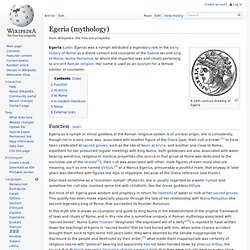
Her name is used as an eponym for a female advisor or counselor. Described sometime as a "mountain nymph" (Plutarch), she is usually regarded as a water nymph and somehow her cult also involved some link with childbirth, like the Greek goddess Ilithyia. But most of all, Egeria gave wisdom and prophecy in return for libations of water or milk at her sacred groves. This quality has been made especially popular through the tale of her relationship with Numa Pompilius (the second legendary king of Rome, that succeeded its founder Romulus); Fortuna. Fortuna (Latin: Fortūna, equivalent to the Greek goddess Tyche) was the goddess of fortune and personification of luck in Roman religion.
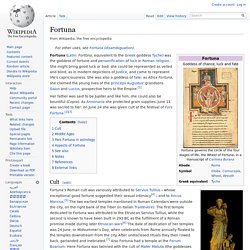
She might bring good luck or bad: she could be represented as veiled and blind, as in modern depictions of Justice, and came to represent life's capriciousness. She was also a goddess of fate: as Atrox Fortuna, she claimed the young lives of the princeps Augustus' grandsons Gaius and Lucius, prospective heirs to the Empire.[1] Her father was said to be Jupiter and like him, she could also be bountiful (Copia). As Annonaria she protected grain supplies. June 11 was sacred to her: on June 24 she was given cult at the festival of Fors Fortuna.[2][3] Geras. Geras, detail of an Attic red-figure pelike, ca. 480 BC–470 BC, Louvre See also[edit] Hesiod's Theogony References[edit] Horae. In Greek mythology the Horae (/ˈhɔːriː/ or /ˈhɔːraɪ/) or Hours (Greek: Ὧραι, Hōrai, pronounced [hɔ̂ːraj], "seasons") were the goddesses of the seasons and the natural portions of time. They were originally the personifications of nature in its different seasonal aspects, but in later times they were regarded as goddesses of order in general and natural justice.
"They bring and bestow ripeness, they come and go in accordance with the firm law of the periodicities of nature and of life", Karl Kerenyi observed: "Hora means 'the correct moment'. Kairos. Kairos (καιρός) is an ancient Greek word meaning the right or opportune moment (the supreme moment). The ancient Greeks had two words for time, chronos and kairos. While the former refers to chronological or sequential time, the latter signifies a time lapse, a moment of indeterminate time in which everything happens. What is happening when referring to kairos depends on who is using the word. While chronos is quantitative, kairos has a qualitative, permanent nature. Kairos also means weather in both ancient and modern Greek. In classical rhetoric[edit] In rhetoric kairos is "a passing instant when an opening appears which must be driven through with force if success is to be achieved.
Moirai. Etymology[edit] The Ancient Greek word moira (μοῖρα) means a portion or lot of the whole, and is related to meros, "part, lot" and moros, "fate, doom",[6] Latin meritum, "desert, reward", English merit, derived from the PIE root *(s)mer, "to allot, assign".[7] Moira may mean portion or share in the distribution of booty (ίση μοίρα, isi moira, "equal booty"),[8] portion in life, lot, destiny, (μοίρα έθηκαν αθάνατοι, moiran ethikan athanatoi, "the immortals fixed the destiny")[9] death -moros- (μοίρα θανάτοιο, moira thanatoio, "destiny of death"), portion of the distributed land.,[10] The word is also used for something which is meet and right (κατά μοίραν, kata moiran, "according to fate, in order, rightly")[11] Kismet, the predetermined course of events in the Muslim religion, seems to have a similar etymology and function. It means Fate or destiny in the Indo-Aryan Urdu language.
Moros. Parcae. The names of the three Parcae were: The earliest extant documents referencing these deities are three small stelae (cippi) found near ancient Lavinium shortly after World War II.[6] They bear the inscription: Porrima. Postverta. Tyche. Tyche (English /ˈtaɪki/; from Greek: Τύχη,[1] meaning "luck"; Roman equivalent: Fortuna) was the presiding tutelary deity that governed the fortune and prosperity of a city, its destiny. Vertumnus. In Roman mythology, Vertumnus — also Vortumnus or Vertimnus — is the god of seasons, change[1] and plant growth, as well as gardens and fruit trees. He could change his form at will; using this power, according to Ovid's Metamorphoses (xiv), he tricked Pomona into talking to him by disguising himself as an old woman and gaining entry to her orchard, then using a narrative warning of the dangers of rejecting a suitor (the embedded tale of Iphis and Anaxarete) to seduce her.
The tale of Vertumnus and Pomona has been called the only purely Latin tale in Ovid's Metamorphoses.[2] Vortumnus' festival was called the Vertumnalia and was held 13 August.[3]